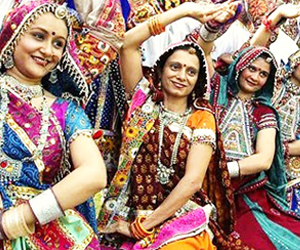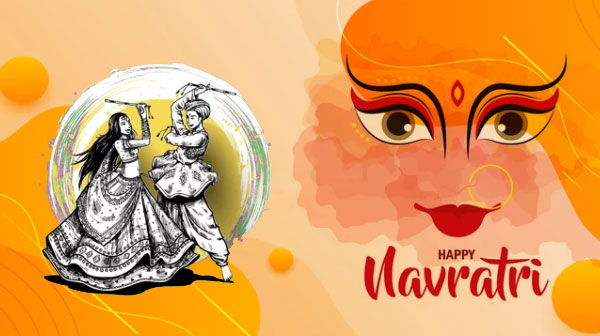Customs of Navratri
Navratri is a major festival of India dedicated to the worship of the deity of power or Shakti. It’s a nine night long celebration. Nearly every Indian household observe this festival with utmost vigour and devotions. Many customs and rituals are associated with the celebration of this festival. Know more about the customs and traditions associated and add more purity to your devotion towards the Goddess.
Navratri is a major festival celebrated all over India for nine nights, dedicated to the worship of Hindu deity Shakti. It comes twice in a year, once around March-April and the second time, around September-October.According to Sanskrit, ‘Nava’ means nine and ‘Ratri’ means night and hence named ‘Navaratri’. The Navaratri is celebrated for nine nights starting from the first night of bright lunar phase in the month of Ashwin, according to the Hindu traditional calendar. Throughout this period, devotees undergo through complete fasting or opt for vegetarian diets. Religious hymns or mantras ( japas) is chanted in honor of Goddess Shakti . Apart from this, there are a number of other customs and rituals as well, which are associated with the festival.
The nine nights are dedicated to the three main goddesses of Hinduism - Parvati, Lakshmi and Saraswati. Navratri is separated into sets of three days. First three days of Navratri are dedicated to Goddess Durga, the Goddess of power and energy. The next three days of Navratri are dedicated to Goddess Lakshmi, the Goddess of wealth and prosperity. The final three days belong to Goddess Saraswati who is worshipped to acquire the spiritual knowledge.
Goddess Durga is also worshipped under nine different names for the nine days in Navratri. Every day, she assumes a new character, a new look and a new duty. For the initial six days Puja celebrations are limited to homes. The celebrations have acquired a festive form since the seventh day when the festivities of Navratri surround the atmosphere.
Customs and Rituals of Navratri

- Before Navrati arrives houses are cleaned and even white washing or painting is done.
- Then the actual ritual of Navratri starts off with placing images of Goddess Durgaat homes as well at temples. Devotees shower their prayers towards the Goddess in forms of bhajans and japas. Fruits and flowers are offered as well in her honor.
- Throughout this devotional span of nine days, nine different forms of Goddess Durga are worshipped. The first day of Navratri is dedicated to Mata Shailputri – First Avatara of Goddess Durga, the Goddess of power and energy. Mata Shailputri holds a ‘Trishul’, a weapon, in her right hand and a lotus in her left hand. She rides on a bull. She has a pleasant smile and blissful looks.
- Mata Brahmacharini is worshipped on the second day of Navratri. Mata personifies love and loyalty. She holds japa mala in her right hand and Kamandal in left hand. She is also known as ‘Uma’ and ‘Tapacharini’ and provides knowledge and wisdom to her devotees.
- Mata Chadraghanta is worshipped on the third day of Navratri. “Chandra” and “Ghanta”, means supreme bliss and knowledge respectively, showering peace and serenity, like cool breeze in a moonlit night. She is very bright and charming. DurgaMaa is astride a tiger, displays a golden hue to HER skin, and possesses ten hands and 3 eyes. Eight of HER hands display weapons while the remaining two are respectively in the mudras of gestures of boon giving and stopping harm.
- Mata Kushmanda is worshipped on the fourth day of Navratri. She shines brightly with a laughing face in all ten directions as the Sun. She controls whole Solar system. In her eight hands, she holds several types of weapons in six hands and a rosary and a lotus in remaining hands. She rides on Lion.
- Skanda Mata is worshipped on the fifth day of Navratri. She had a son ‘Skandaa and holds him on her lap. She has three eyes and four hands; two hands hold lotuses while the other 2 hands respectively display defending and granting gestures. It is said, by the mercy of Skandmata, even the idiot becomes an ocean of knowledge.
- Mata Katyayani is worshipped on the Sixth Day of Navratri. Ma Katyayani has three eyes and four hands. The left hand holds a weapon and the other a lotus. She rides on a lion.
- Mata Kalaratri is worshipped on the Seventh Day of Navratri. She is dark and black like the night; hence she is called as ‘Kalratri’. Her hairs are unlocked and have three eyes and four hands. While the remaining two are in the mudras of “giving” and “protecting”. HER vahana is a faithful donkey. The destroyer of darkness and ignorance. She spills out fire from her nostrils. Holding a sharp sword in her right hand she blesses her devotees with her lower hand.
- Mata MahaGauri is worshipped on the Eighth Day of Navratri. MahaGauri looks as white as the moon and jasmine. She has three eyes and four hands. Peace and compassion radiate from her being and she is often dressed in a white or green sari. She holds a drum and a trident and is often depicted riding a bull.
- Mata Siddhidatri is the worshipped on the Ninth Day of Navratri. Siddhidatri Devi is worshipped by all Gods, Rishis, Muniswaras, Siddha yogis, and all common devotees who want to attain the religious assent.
- Dandiya and Garba are the featured dances performed in the evenings of Navratri, mainly in Gujarat. Garba which is considered to be a devotional dance whichis performed before the 'Aarti', in the honor of the Goddess, while Dandiya is performed after it, as a part of the celebrations.
- The nine-day Navratra celebrations, which fall in September-October, come to an end with the immersion of the idols of Goddess Durga in water.
- The tenth day is celebrated as Dussehra. On this day, devotees perform 'Saraswati Puja', to acquire blessings of knowledge and mental peace. On that very day, the dummy of demon king Ravanais burnt to wipe off evil and bad spirits from earth.

Looking for Something? Search Google :

 Friendship Day
Friendship Day Good Morning
Good Morning